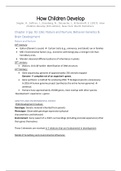Samenvatting
Developmental and Educational Psychology - Summary
- Instelling
- Universiteit Leiden (UL)
- Boek
- How Children Develop
This is an English summary of the book "How Children Develop" for the first year course Developmental and Educational Psychology. It contains the relevant parts of the chapters needed for the exam in 2018, chapters 2-14. Key words, age statements and information from the lecture slides are included...
[Meer zien]





